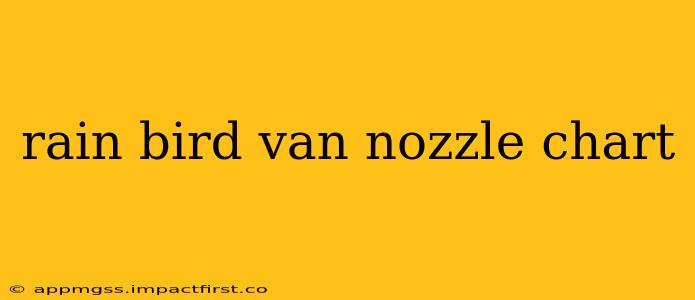Choosing the right nozzle for your Rain Bird Van sprinkler is crucial for efficient and effective irrigation. This comprehensive guide will help you understand Rain Bird Van nozzle charts, how to interpret them, and select the best nozzle for your specific landscaping needs. We'll also address common questions related to Rain Bird Van nozzles.
What is a Rain Bird Van Nozzle Chart?
A Rain Bird Van nozzle chart is a visual guide that shows the relationship between different nozzle sizes and their resulting spray patterns and water distribution. This chart is vital for determining the appropriate nozzle to use based on your landscape's spacing and water requirements. These charts typically detail the precipitation rate (inches per hour), radius (distance the water sprays), and flow rate (gallons per minute) for each nozzle size. Understanding these parameters allows for precise irrigation design and efficient water usage.
How to Read a Rain Bird Van Nozzle Chart
While specific Rain Bird Van nozzle charts vary slightly depending on the model and generation, they generally follow a consistent format. Look for these key pieces of information:
- Nozzle Size: This is usually indicated by a number (e.g., 4, 6, 8), which represents the nozzle's internal diameter in 32nds of an inch. A larger number means a larger nozzle opening and, consequently, a greater flow rate and spray radius.
- Radius: This indicates the distance the water sprays from the sprinkler head in feet. Different nozzle sizes will produce different radii, affecting the area covered.
- Precipitation Rate: This measurement (typically in inches per hour) shows how much water is applied per hour over the area covered by the sprinkler. Proper precipitation rate ensures even watering without over- or under-watering.
- Flow Rate: The flow rate (measured in gallons per minute, or GPM) is the amount of water the nozzle discharges per minute. This is crucial for calculating your overall water usage and ensuring sufficient water supply.
What factors should I consider when choosing a Rain Bird Van nozzle?
Selecting the right Rain Bird Van nozzle depends on several crucial factors:
- Spacing between Sprinklers: Closer spacing requires smaller nozzles to avoid overlapping spray patterns and water waste. Wider spacing demands larger nozzles to cover the area adequately.
- Landscape Type: Different plants have varying water requirements. Areas with dense vegetation or thirsty plants may require higher precipitation rates. Conversely, less water-intensive landscaping can tolerate lower rates.
- Soil Type: Sandy soils drain quickly, requiring more frequent but lower-intensity watering, while clay soils retain water longer, needing less frequent but potentially higher-intensity watering.
- Water Pressure: The water pressure in your system significantly affects the performance of the nozzle. Higher pressure often necessitates smaller nozzles to avoid overwatering.
Where can I find a Rain Bird Van nozzle chart?
Rain Bird provides comprehensive information and resources on their website. You should be able to locate the appropriate nozzle chart for your specific Van sprinkler model there. Alternatively, contacting your local irrigation supplier or a landscape professional can provide assistance in selecting the right nozzle for your needs.
How do I calculate the correct precipitation rate for my landscape?
Calculating the correct precipitation rate involves considering your soil type, plant requirements, and the desired watering frequency. While there isn't a single formula to apply universally, the Rain Bird Van nozzle chart gives you the precipitation rate for each nozzle size. You then need to determine which rate best suits the needs of your specific plants and soil conditions. Overwatering can lead to root rot, while underwatering will stress plants.
What are the common problems associated with using the wrong Rain Bird Van nozzle?
Using the wrong nozzle can result in several issues:
- Uneven Watering: Incorrect nozzle selection leads to inconsistent water distribution across your landscape. Some areas might be overwatered, leading to runoff and wasted water, while others might be underwatered, resulting in stressed or dead plants.
- Water Waste: Overwatering is a significant contributor to water waste. The right nozzle size ensures efficient water usage.
- Runoff: Too much water applied too quickly leads to runoff, which not only wastes water but also carries away valuable nutrients from your soil.
By understanding Rain Bird Van nozzle charts and considering the factors discussed above, you can optimize your irrigation system for maximum efficiency and healthy plant growth. Remember that consulting with a professional can provide valuable insights and ensure proper installation and maintenance of your irrigation system.
